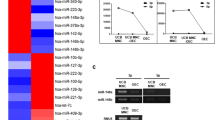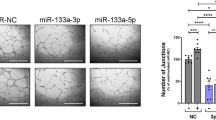Abstract
Angiogenesis is controlled positively or negatively by extrinsic and intrinsic molecular cues in endothelial cells (ECs); in the tumor microenvironment, the action of positive regulators exceeds that of negative regulators. Thus, overinduction of negative regulators may inhibit tumor angiogenesis. MicroRNAs (miRNAs or miRs) are endogenous short noncoding RNAs regulating gene expression either through translational inhibition or destabilization of target mRNA. Here, we show that miR-125b expression is transiently induced in ECs on stimulation with vascular endothelial growth factor or by ischemia. miR-125b inhibits translation of vascular endothelial (VE)-cadherin mRNA and in vitro tube formation by ECs. Injection of miR-125b into the tumor inhibited VE-cadherin expression by ECs and induced nonfunctional blood vessel formation, resulting in inhibition of tumor growth. It has been suggested that pro-angiogenic signals in ECs also upregulate anti-angiogenic molecules simultaneously via negative feedback. Because miR-125b induction in ECs is transient after pro-angiogenic stimulation, prolonged overexpression of miR-125b could result in blood vessel regression. Thus, miR-125b may be useful in cancer therapy by causing the collapse of the lumen of ECs.
This is a preview of subscription content, access via your institution
Access options
Subscribe to this journal
Receive 50 print issues and online access
$259.00 per year
only $5.18 per issue
Buy this article
- Purchase on Springer Link
- Instant access to full article PDF
Prices may be subject to local taxes which are calculated during checkout







Similar content being viewed by others
References
Risau W . Mechanisms of angiogenesis. Nature 1997; 386: 671–674.
Dejana E . Endothelial adherens junctions: implications in the control of vascular permeability and angiogenesis. J Clin Invest 1996; 98: 1949–1953.
Lindahl P, Johansson BR, Leveen P, Betsholtz C . Pericyte loss and microaneurysm formation in PDGF-B-deficient mice. Science 1997; 277: 242–245.
Dumont DJ, Gradwohl G, Fong GH, Puri MC, Gertsenstein M, Auerbach A et al. Dominant-negative and targeted null mutations in the endothelial receptor tyrosine kinase, tek, reveal a critical role in vasculogenesis of the embryo. Genes Dev 1994; 8: 1897–1909.
Sato TN, Tozawa Y, Deutsch U, Wolburg-Buchholz K, Fujiwara Y, Gendron-Maguire M et al. Distinct roles of the receptor tyrosine kinases Tie-1 and Tie-2 in blood vessel formation. Nature 1995; 376: 70–74.
Suri C, Jones PF, Patan S, Bartunkova S, Maisonpierre PC, Davis S et al. Requisite role of angiopoietin-1, a ligand for the TIE2 receptor, during embryonic angiogenesis. Cell 1996; 87: 1171–1180.
Augustin HG, Koh GY, Thurston G, Alitalo K . Control of vascular morphogenesis and homeostasis through the angiopoietin-Tie system. Nat Rev Mol Cell Biol 2009; 10: 165–177.
Maisonpierre PC, Suri C, Jones PF, Bartunkova S, Wiegand SJ, Radziejewski C et al. Angiopoietin-2, a natural antagonist for Tie2 that disrupts in vivo angiogenesis. Science 1997; 277: 55–60.
Vestweber D, Winderlich M, Cagna G, Nottebaum AF . Cell adhesion dynamics at endothelial junctions: VE-cadherin as a major player. Trends Cell Biol 2009; 19: 8–15.
Dejana E, Tournier-Lasserve E, Weinstein BM . The control of vascular integrity by endothelial cell junctions: molecular basis and pathological implications. Dev Cell 2009; 16: 209–221.
Gory-Faure S, Prandini MH, Pointu H, Roullot V, Pignot-Paintrand I, Vernet M et al. Role of vascular endothelial-cadherin in vascular morphogenesis. Development 1999; 126: 2093–2102.
Carmeliet P, Lampugnani MG, Moons L, Breviario F, Compernolle V, Bono F et al. Targeted deficiency or cytosolic truncation of the VE-cadherin gene in mice impairs VEGF-mediated endothelial survival and angiogenesis. Cell 1999; 98: 147–157.
Crosby CV, Fleming PA, Argraves WS, Corada M, Zanetta L, Dejana E et al. VE-cadherin is not required for the formation of nascent blood vessels but acts to prevent their disassembly. Blood 2005; 105: 2771–2776.
Hendrix MJ, Seftor EA, Meltzer PS, Gardner LM, Hess AR, Kirschmann DA et al. Expression and functional significance of VE-cadherin in aggressive human melanoma cells: role in vasculogenic mimicry. Proc Natl Acad Sci USA 2001; 98: 8018–8023.
Bartel DP . MicroRNAs: genomics, biogenesis, mechanism, and function. Cell 2004; 116: 281–297.
Krek A, Grun D, Poy MN, Wolf R, Rosenberg L, Epstein EJ et al. Combinatorial microRNA target predictions. Nat Genet 2005; 37: 495–500.
Suarez Y, Sessa WC . MicroRNAs as novel regulators of angiogenesis. Circ Res 2009; 104: 442–454.
Wurdinger T, Tannous BA, Saydam O, Skog J, Grau S, Soutschek J et al. miR-296 regulates growth factor receptor overexpression in angiogenic endothelial cells. Cancer Cell 2008; 14: 382–393.
Bonauer A, Carmona G, Iwasaki M, Mione M, Koyanagi M, Fischer A et al. MicroRNA-92a controls angiogenesis and functional recovery of ischemic tissues in mice. Science 2009; 324: 1710–1713.
Kuehbacher A, Urbich C, Zeiher AM, Dimmeler S . Role of Dicer and Drosha for endothelial microRNA expression and angiogenesis. Circ Res 2007; 101: 59–68.
Chen YH, Wu HL, Chen CK, Huang YH, Yang BC, Wu LW . Angiostatin antagonizes the action of VEGF-A in human endothelial cells via two distinct pathways. Biochem Biophys Res Commun 2003; 310: 804–810.
Yamakuchi M, Lotterman CD, Bao C, Hruban RH, Karim B, Mendell JT et al. P53-induced microRNA-107 inhibits HIF-1 and tumor angiogenesis. Proc Natl Acad Sci USA 2010; 107: 6334–6339.
Suzuki HI, Yamagata K, Sugimoto K, Iwamoto T, Kato S, Miyazono K . Modulation of microRNA processing by p53. Nature 2009; 460: 529–533.
Scott GK, Goga A, Bhaumik D, Berger CE, Sullivan CS, Benz CC . Coordinate suppression of ERBB2 and ERBB3 by enforced expression of micro-RNA miR-125a or miR-125b. J Biol Chem 2007; 282: 1479–1486.
Shi XB, Xue L, Yang J, Ma AH, Zhao J, Xu M et al. An androgen-regulated miRNA suppresses Bak1 expression and induces androgen-independent growth of prostate cancer cells. Proc Natl Acad Sci USA 2007; 104: 19983–19988.
Niola F, Evangelisti C, Campagnolo L, Massalini S, Bue MC, Mangiola A et al. A plasmid-encoded VEGF siRNA reduces glioblastoma angiogenesis and its combination with interleukin-4 blocks tumor growth in a xenograft mouse model. Cancer Biol Ther 2006; 5: 174–179.
Okamoto R, Ueno M, Yamada Y, Takahashi N, Sano H, Suda T et al. Hematopoietic cells regulate the angiogenic switch during tumorigenesis. Blood 2005; 105: 2757–2763.
Takakura N . Role of hematopoietic lineage cells as accessory components in blood vessel formation. Cancer Sci 2006; 97: 568–574.
Baumer S, Keller L, Holtmann A, Funke R, August B, Gamp A et al. Vascular endothelial cell-specific phosphotyrosine phosphatase (VE-PTP) activity is required for blood vessel development. Blood 2006; 107: 4754–4762.
Gotsch U, Borges E, Bosse R, Boggemeyer E, Simon M, Mossmann H et al. VE-cadherin antibody accelerates neutrophil recruitment in vivo. J Cell Sci 1997; 110 (Pt 5): 583–588.
Holash J, Maisonpierre PC, Compton D, Boland P, Alexander CR, Zagzag D et al. Vessel cooption, regression, and growth in tumors mediated by angiopoietins and VEGF. Science 1999; 284: 1994–1998.
Kidoya H, Ueno M, Yamada Y, Mochizuki N, Nakata M, Yano T et al. Spatial and temporal role of the apelin/APJ system in the caliber size regulation of blood vessels during angiogenesis. EMBO J 2008; 27: 522–534.
Yamada Y, Takakura N . Physiological pathway of differentiation of hematopoietic stem cell population into mural cells. J Exp Med 2006; 203: 1055–1965.
Kidoya H, Kunii N, Naito H, Muramatsu F, Okamoto Y, Nakayama T et al. The apelin/APJ system induces maturation of the tumor vasculature and improves the efficiency of immune therapy. Oncogene 2012; 31: 3254–3264.
Nagahama Y, Ueno M, Miyamoto S, Morii E, Minami T, Mochizuki N et al. PSF1, a DNA replication factor expressed widely in stem and progenitor cells, drives tumorigenic and metastatic properties. Cancer Res 2010; 70: 1215–1224.
Takakura N, Watanabe T, Suenobu S, Yamada Y, Noda T, Ito Y et al. A role for hematopoietic stem cells in promoting angiogenesis. Cell 2000; 102: 199–209.
Acknowledgements
We thank S Fukuhara and N Mochizuki for supplying VE-cadherin expression plasmid, and K Fukuhara and N Fujimoto for technical assistance. This work was partly supported by a grant from the Ministry of Education, Science, Sports, and Culture of Japan.
Author information
Authors and Affiliations
Corresponding author
Ethics declarations
Competing interests
The authors declare no conflict of interest.
Additional information
Supplementary Information accompanies the paper on the Oncogene website
Supplementary information
Rights and permissions
About this article
Cite this article
Muramatsu, F., Kidoya, H., Naito, H. et al. microRNA-125b inhibits tube formation of blood vessels through translational suppression of VE-cadherin. Oncogene 32, 414–421 (2013). https://doi.org/10.1038/onc.2012.68
Received:
Revised:
Accepted:
Published:
Issue Date:
DOI: https://doi.org/10.1038/onc.2012.68
Keywords
This article is cited by
-
Non-coding RNAs in lung cancer: emerging regulators of angiogenesis
Journal of Translational Medicine (2022)
-
Over-expression of miR-183-5p or miR-492 triggers invasion and proliferation and loss of polarity in non-neoplastic breast epithelium
Scientific Reports (2022)
-
LncRNA NNT-AS1 regulates proliferation, ECM accumulation and inflammation of human mesangial cells induced by high glucose through miR-214-5p/smad4
BMC Nephrology (2021)
-
A risk progression breast epithelial 3D culture model reveals Cx43/hsa_circ_0077755/miR-182 as a biomarker axis for heightened risk of breast cancer initiation
Scientific Reports (2021)
-
Long non-coding RNA MALAT1 enhances angiogenesis during bone regeneration by regulating the miR-494/SP1 axis
Laboratory Investigation (2021)



